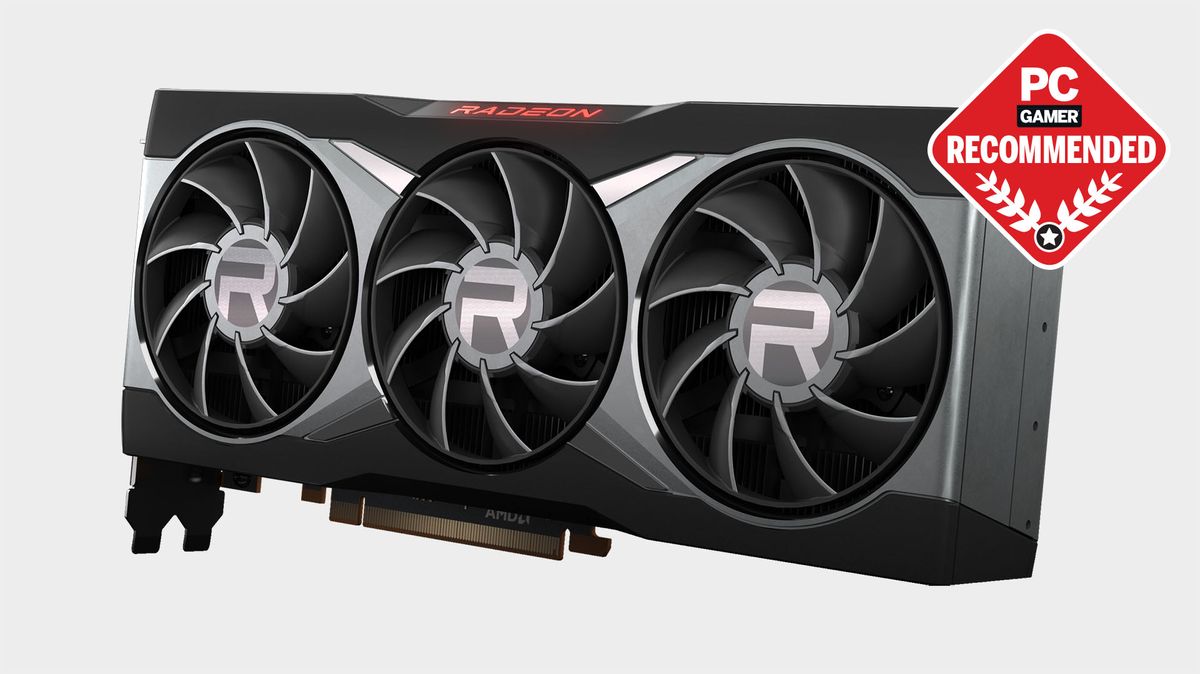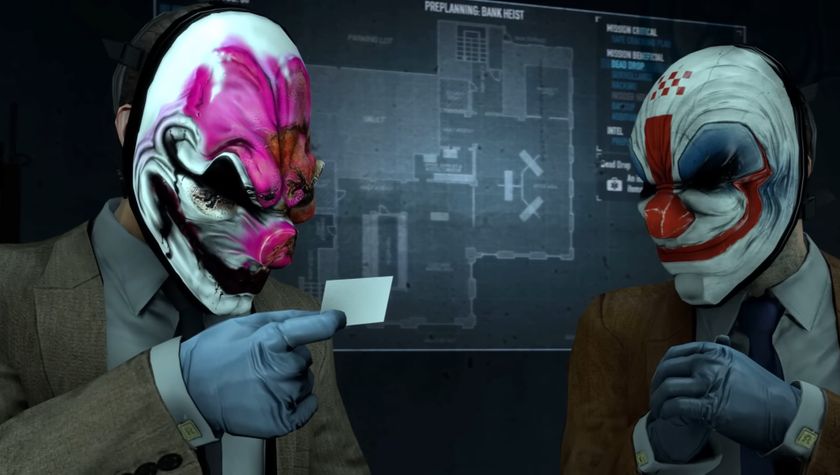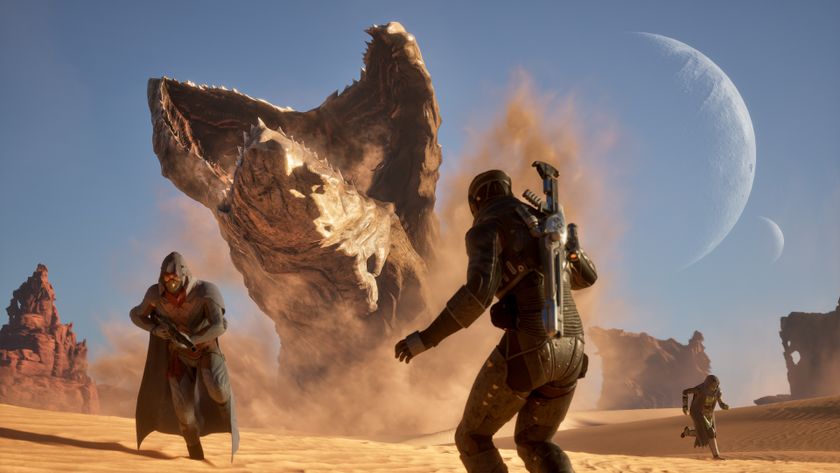Our Verdict
With the launch of the Radeon RX 6800 XT, AMD can claim 4K-capable performance in earnest. It marks a huge step in the right direction for team red, and delivers genuine competition to Nvidia's high-end.
For
- 4K performance
- Cheaper than an RTX 3080
- Cooler performance
- Large GDDR6 capacity
Against
- Moderate ray tracing performance
- Slower than an RTX 3080 at 4K
- No DLSS alternative at launch
PC Gamer's got your back
The AMD Radeon RX 6800 XT is the best representation of the RDNA 2 inflection point that has accompanied the red team's latest gaming architecture. It's a high-end graphics card unlike really any we've seen from AMD in recent years, the RX 6800 XT is right on time, competitive, and without caveat when it comes to gaming performance in a wide range of modern games.
That's not to say AMD hasn't had some superb graphics cards in the past—the RX 480 stands out for its tremendous value proposition over the duration of its lengthy time with us. No, what I mean is that the RX 6800 XT is competitive at a level which AMD hasn't been able to reach for some time, and it does not require a generous helping of in-game optimisations from hard-pressed developers to get there.
The second generation of an architecture tailor-made for gaming, RDNA 2 is not just an incremental step towards high-end performance, but rather a staggering leap.
What was once only competitive with Nvidia's third-run GPUs, the RDNA architecture has come on drastically with only a single turn of the crank. It now sits provisionally alongside Nvidia's enthusiast class RTX 3080 and RTX 3090, and that's no simple feat.
So how did AMD play catch up? There's a lot to discuss when it comes to RDNA 2 and the RX 6800 XT. From Infinity Cache to Ray Accelerators, the Navi 21 die isn't without shiny new things to lure the avid PC gamer. But, perhaps most importantly, the RX 6800 XT is also a lesson in how dragging Intel kicking and screaming from its gaming throne offered more than just the know-how to make a decent CPU.
Let's just say that AMD has figured out a few techniques that don't go amiss whether you're aiming for an IPC increase with a brand new CPU or building out a more performant GPU.
AMD RDNA 2 architecture

AMD RDNA 2 architecture
With a continuation of the 7nm process, you'd be easily fooled into thinking that there's little to talk about when it comes to performance per watt and clock speed. RDNA 2 pulls no punches in either, offering 30 percent higher frequency for the same power draw as the previous generation, or 50 percent greater power savings while holding the same frequency.
That cross-pollination of ideas and methodologies between Zen and RDNA 2 starts here: In order to improve performance while retaining roughly the same process node, AMD has incorporated custom libraries, tools, methodologies, and structures used to build Ryzen 5000-series CPUs into RDNA 2 in order to run it at higher frequencies or the same frequencies for less power.
Those have clearly been successful. For a clear cut example of the initial power savings and 7nm optimisations, just look to the first-generation RDNA top dog: the RX 5700 XT. This first wave card delivers 40 CUs at 225W with a top clock of 1,905MHz. The RX 6900 XT doubles the CUs, all of which run up to 18 percent faster, for just 33.33 percent greater power.
To further help the architecture along AMD has built in further capacitance in alternating current (CAC) optimisations right down to the metal with RDNA 2. These optimisations go down to the very capacitance of transistors as they switch. It's all in order to ensure that a maximum benefit and power saving is being achieved at a transistor and clock level. From there, it's all about scaling up an architecture that just doesn't waste any juice.
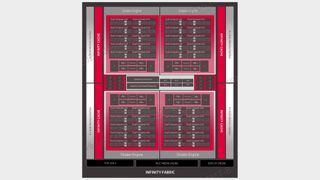
At a base level you're already getting more performance out of the same components with RDNA 2, but that doesn't make for a lax approach on a uniquely architectural level. From here AMD's building out with an eye on maintaining a level of efficiency throughout, and not blowing the entire power budget on a 512-bit bus, I'm told.
AMD really wants people to know bandwidth is not all about bus width—forget what ya heard.
A 512-bit bus, AMD explains, is costly and large. Two things AMD of all companies knows it can't get away with. That's also why you'll not see HBM2 memory anywhere near RDNA 2's hallowed PCB either. Instead, AMD is incorporating a new concept with RDNA 2: Infinity Cache.
Infinity Cache is what you might call a cure-all for AMD's GPU issues of the past— its gaming panacea, so to speak. It's a close relation to Infinity Fabric, the interconnect used throughout Zen 2 and Zen 3 CPUs. In fact, it's the work that AMD's engineers carried out on its EPYC server chips that led to such a cache technology making its way to RDNA 2 in the first place.
Cache is effectively organised into serialised banks within EPYC, one after the other. That's great for a CPU, but when it comes to the highly parallelised workloads of a GPU that simply won't cut it. So that's why AMD took its CPU cache and made it increasingly more parallel in the Infinity Cache.
"An architecture that's easy for the industry to adopt"
Laura Smith, senior director, RTG
The result is a cache subsystem that, AMD says, offers an effective bandwidth far exceeding the physical 256-bit one. One that can turn 512GB/s bandwidth into 1,664GB/s. In other words, 3.25x the effective bandwidth of a 256-bit cache. And without the power demands of a doubly wide bus and without taking up too much die space—in comparison to a larger surrounding bus, anyways. The Infinity Cache is still a sizeable chunk of the Navi 21 die.
Much like Zen 3's unified L3 cache, AMD's engineers were apparently surprised with the performance a larger cache system could offer. Yet clearly it works, and at low power consumption. We can't compare to a 512-bus, simply we don't have that point of comparison available, but the effective bandwidth of Infinity Cache appears a smart and functional workaround.
At least when you get a hit on that cache. AMD says it only manages to do just that some 60-80 percent of the time depending on the resolution—cache hits are more likely at 1080p, but you're also less likely to hit a memory bandwidth brick wall at lower resolutions.
The 128MB of Infinity Cache effectively takes the place of calls to external memory most of the time, meaning your GPU doesn't have to wait around for external memory or a PCIe bus to relay a signal, and thus effective memory bandwidth is increased in games where that comes into play most, most of all at 4K.
And that's partially why AMD can finally, almost, compete with its rival at 4K resolutions, a hurdle that had seemed insurmountable only a couple of generations ago.
Yet this is not the only workload where Infinity Cache helps AMD find precious performance. RDNA 2 sees the first integration of hardware-accelerated ray tracing for AMD: a new block called a Ray Accelerator. There's a single Ray Accelerator per compute unit, which makes for two blocks per dual CU block, in a similar configuration to those in the initial RDNA architecture.
Therefore the number of Ray Accelerators is dependent on overall CU count. In the RX 6800 XT's case, that's 72. As such you can expect a sliding scale of ray tracing performance through the stack, from the 20 CU Xbox Series S to the 80 CU RX 6900 XT.
Each of these Ray Accelerators is capable of accelerating the intersection of rays within a ray-traced BVH structure, or bounding volume hierarchy, taking care of four ray/box intersections per clock or one ray/triangle intersection per clock. A bounding volume hierarchy is the same acceleration technique accelerated in RTX graphics cards from Nvidia—a tree like structure of boxes within boxes containing sets of objects in a scene, like a Russian nesting doll stuffed with geometry.
It's all still based on Microsoft's DirectX Raytracing API, so any DX12-based title with ray tracing built into it is using DXR, and that means both AMD and Nvidia can support the new lighting techniques. On games sporting Vulkan workarounds, however, it's all a bit more proprietary.
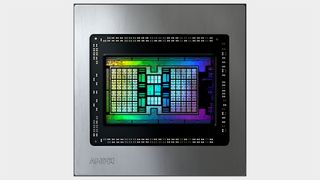
The rest of the ray tracing equation, including denoising, is taken care of by shader code on the compute units. There's no dedicated denoising block such as Nvidia's Tensor Core within RDNA 2, and that means you won't see any accelerated AI inference workloads on the RX 6000-series, although GPUs tend to be pretty good at those anyways.
What's a boon to ray tracing performance, however, is that Infinity Cache, which can itself store a "high percentage" of relevant BVH information and thus reduces the latency of each ray traced frame. Those could be killer for frame times otherwise, as logic is too busy with BVH intersections to deal with the all-important standard rendering stuff.
So you've got multiple uses for Infinity Cache, and that's by design in order to offer what AMD calls a hybrid rendering solution—one that offers a blend of rasterised rendering performance and ray tracing performance.
AMD has not got its foot as heavily on the ray tracing pedal as Nvidia, which will become abundantly clear once we reach the performance figures a little later on. Instead, AMD is focusing on this hybrid approach, one that it deems necessary to make it worthwhile for both gamers at 1440p and developers.
Speaking of which, programming transparency is key this generation. AMD aims to create "an architecture that's easy for the industry to adopt", and Infinity Cache has been built around a concept of requiring no prerequisite developer support. That means its impact should be felt more immediately and for longer—what the devs don't know can't hurt them.
That doesn't mean there's no potential avenue for extra developer-side support for Infinity Cache in the future. AMD says that's one possible avenue for improved optimisation on RDNA 2 GPUs, which both the Xbox Series X and PlayStation 5 have inside them. It's absolutely true that today there's more reason than ever to build your game with an eye to optimising for modern red team tech.
AMD RX 6800 XT specs
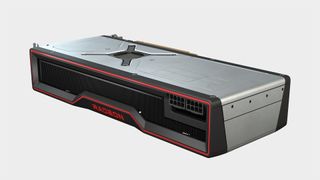
AMD RX 6800 XT specifications
The RX 6800 XT will enter the fray as AMD's most powerful graphics card to date, but will only hold that station until December 8, 2020, when the RX 6900 XT will surpass it for a chunk more change. The difference between the two is only minimal, really—these cards differ only in price and compute unit count: $649 to $999 and 72 CUs to 80 CUs, respectively.
The RX 6800 XT's 72 CUs contain 4,608 stream processors in total. That's 64 per CU, the same as first generation RDNA albeit on a greater scale. AMD says it will run at a moderate 2,015MHz game clock, while boosting up to 2,250MHz. That's a little on the conservative side, though, as we saw the card with some sticking power around 2,200MHz and easily break 2,300MHz in-game.
That's even without Rage Mode enabled, the new performance preset available on the RX 6800 XT and RX 6900 XT. This allows the card to operate within any extra headroom available for both power and fan-speed limits, and essentially cranks the clock speeds up a step or two. Technically Rage Mode offers a game clock of 2,065MHz and a boost clock of 2,310MHz on the RX 6800 XT, but the exact specification and behaviour can vary per chip and per cooler design, so your results may vary.
GPU - Navi 21
Lithography - TSMC 7nm
Die size - 519 mm2
Transistors - 26.8bn
Stream processors - 4,608
CUs - 72
Ray Accelerators - 72
GPU Game clock - 2,015MHz
GPU Boost clock - 2,250MHz
Memory bus - 256-bit
Memory capacity - 16GB GDDR6
Memory speed - 16Gbps
Memory bandwidth - 512GB/s
TGP - 300W
Recommended power supply - 750W
Size - 2.5-slot
Price (reference) - $649
So much so that our review sample seems to be one of the few that doesn't see much uplift whatsoever with Rage Mode enabled—we're talking a frame or two gained at its best, and a handful of frames dropped at its worst. Guess we weren't one of the lucky ones.
Rage Mode is just the 'safe option', however. You're more than welcome to overclock this chip further, if you can.
Both the RX 6800 XT and 80CU RX 6900 XT share the same 300W TGP (or TBP, total board power, by AMD's convention). AMD tells us the matching spec is simply down to the way it has constructed the product specification, which alludes to a potential binning process for the 80 CU chips destined for the high-end card. Yet we took that as a sign that the 72 CU card may be a good candidate for a healthy undervolt or judicious overclock.
More on that later. And anyways, the RX 6800 XT doesn't need a helping hand taking aim at Nvidia's RTX 3080—it's just icing on the cake. Beyond an eye to delivering performance roughly on par to that of the Ampere flagship card (although you can see how that shapes up in the graphs below), AMD is also looking to spread the good word of 4K gaming for $50 less.
Another of the key battlegrounds for both companies' 4K cards this generation has been in memory bandwidth and capacity—or at least that's what AMD is looking to instigate a heated discussion about.
Memory and Infinity Cache is uniform across the RX 6000-series. As such, the RX 6800 XT comes with 16GB of GDDR6 across a 256-bit bus for a total bandwidth of 512GB/s and 128MB of Infinity Cache to bolster that further—the same as the RX 6800 and RX 6900 XT. That means AMD has Nvidia's RTX 3080 on the ropes in terms of capacity, but falls slightly behind in raw bandwidth to the RTX 3080's 760GB/s.
That's without the Infinity Cache factored in, however, and as I mentioned before you're looking at a considerable 'effective bandwidth' as a result of the 128MB cache. Some 1,664GB/s, by AMD's making—a 3.25x improvement over the RX 6800 XT's raw bandwidth.
We're looking at two very different approaches from AMD and Nvidia with this GPU generation, and perhaps not what you'd have been expecting from either company looking only a year or so back. How that all stacks up in game, well, you'll see just below.
AMD RX 6800 XT performance
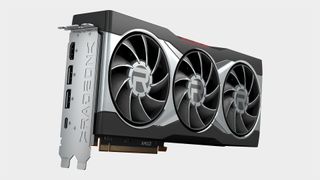
AMD RX 6800 XT performance
And what's all that smart architectural jostling good for if not gaming performance? RDNA is a gaming-first architecture, after all, and for your patience and stick-to-itiveness bearing with successive mid-tier cards, AMD is finally ready to gift the world a truly capable high-end 4K graphics card in the RX 6800 XT.
4K gaming performance









If a large memory pool is to become a key player in 4K performance it certainly isn't all that important just yet
Across some of the latest games in our testing suite, the RX 6800 XT manages 60+ fps at 4K with ultra (or highest) graphics settings enabled. That's the 4K stamp of approval in The Division 2, Shadow of the Tomb Raider, Metro Exodus, Horizon Zero Dawn, F1 2020, Civ 6, and Wolfenstein Youngblood.
It's only marginally off the mark in Total War: Three Kingdoms, too, which is a more demanding benchmark on all aspects of our test rig. Similarly, you may want to knock down the graphical fidelity a touch in order to maintain steady 60+ fps in Metro Exodus, Wolfenstein, and The Division, all of which see some less than ideal minimum frame rates.
To answer the question at the forefront of most PC builders' minds today: The RX 6800 XT comes in a little short of the RTX 3080 at 4K. Occasional flares for brilliance shine out from results otherwise overwhelmingly in favour of the green team's high-end graphics card. If a large memory pool is to become a key player in 4K performance, which is where the RX 6800 XT has the RTX 3080 roundly beat, it certainly isn't all that important just yet.
We're likely to see some benefit to that larger VRAM at some point in time—whether within the shelf life of this GPU generation, who can say. Like a great deal of the feature support introduced with the latest generations from both AMD and Nvidia, it may be years before any become must-haves. Variable Rate Shading, Mesh Shaders, Sampler Feedback, and DirectStorage will all likely have a tremendous impact—one day.
Yet further to that point, there's some confirmed performance to come in the form of FidelityFX Super Resolution, which AMD has said it plans to integrate into its driver package at some point in the future. There's no confirmed release date for this feature today, and while AMD has every confidence it will receive wide adoption, a promise alone is far too ethereal to have any weight in the RX 6800 XT's standing today.
1440p gaming performance








It's not all a question of 4K performance, however, and the RX 6800 XT also shows its strengths as a 1440p graphics card. In a wide range of games the RX 6800 XT will deliver 144Hz or more for silky smooth gaming right in that gaming monitor sweet spot.
It's a much more close-run affair between the RX 6800 XT and RTX 3080 at 1440p, too. The RX 6800 XT manages to eke out the win in a couple of games, often splitting the difference between the RTX 3080 and RTX 3090, yet loses out in just as many.
1080p gaming performance








It's unlikely 1080p will factor much into a decision to buy an RX 6800 XT, yet it's where the card delivers its best comparative results against the RTX 3080. On a rare occasion even the RTX 3090 takes a kicking—for all 12 of you enjoying your $1,499 graphics card at 1080p.
AMD expects the Infinity Cache to operate at its highest accuracy at 1080p, which may go some ways to explaining the lead, yet memory will also play a lesser role at this resolution by some margin. So it may be more so due to the more effective use of the fewer cores within the RX 6800 XT at a higher clock speed that sees it deliver its best at 1080p.
Ray tracing performance


There are now two 3DMark provided benchmarks for putting ray tracing silicon to the test: Port Royal and the DirectX Raytracing Feature Test. Port Royal is a hybrid mix of ray-traced effects and rasterised rendering, so it's a little more gaming-adjacent than the purely ray-traced DirectX Raytracing benchmark.
In Port Royal, the RX 6800 XT is unable to keep up with the RTX 3080's new RT Core/Tensor Core configuration. There's something to be said of the RX 6800 XT managing to maintain a small advantage over the RTX 2080 Ti, yet that's more to do with the rasterised rendering lead the RDNA 2 GPU delivers over Nvidia's top Turing chip than its specific ray tracing acceleration's capabilities.
The feature test is more so an apples to apples ray tracing benchmark, in very loose terms. As a fully single pass ray-traced scene, the benchmark removes as much of the rasterised performance imbalance from the equation as possible. Essentially meaning you're testing raw ray tracing silicon alone. Well, something close to that, anyways. Both Nvidia and AMD use compute shaders for a portion of the ray tracing pipeline, so it's not quite RT Core vs. Ray Accelerator for either benchmark.
Once again, it's the RTX 3080 that takes the lead—and by some margin, too. Nvidia has made a concerted effort to generate a ray tracing solution that negates the burden of the physics-mimicking rendering technique in Ampere, and it shows.
The RX 6800 XT delivers enough to match AMD's 1440p ray tracing promise, at least, but nothing more.
Power and thermal



CPU - Intel Core i7 10700K
Motherboard - MSI MPG Z490 Gaming Carbon WiFi
RAM - Corsair Vengeance RGB Pro @ 3,200MHz
CPU cooler - Corsair H100i RGB Pro XT
PSU - NZXT 850W
Chassis - DimasTech Mini V2
Now, you may be surprised to learn that the RX 6800 XT is cool and quiet. Going against pre-launch speculation, and, admittedly, our expectations based on previous reference AMD cooler designs. The RX 6800 XT's triple-fan cooler is able to keep the Navi 21 GPU to a low rumble while gaming.
I suppose a change from the usual blower-style design was necessitated by the 300W TDP of the RX 6800 XT, which the board is all to happy to consume. The design also comes out a little higher at its peak than the RTX 3080, but with generally lower power demands throughout benchmarking it's actually looking like the more power-savvy design.
Yet the RTX 3080 does put the available wattage to better use, if only by a sliver. At 0.23 frames/J (Joules being the equivalent of one Watt dissipated as heat for one second), the RTX 3080 is a touch more efficient than the RX 6800 XT at 0.22 frames/J.
Perhaps helping to explain that lead at 1080p somewhat, the RX 6800 XT is the more efficient GPU at lower resolution.
Overclocking and undervolting







With Rage Mode increasing average power consumption, clock speed, and temperature for no performance gain whatsoever in Metro Exodus (in fact, performance actually dropped by a hair), I hadn't much hope for an overclock actually coming through for me on the RX 6800 XT.
But not one to be deterred, I took to a manual overclock through the tuning tab in the Radeon Adrenalin Software. A 156MHz offset to GPU core clock is achieved easily enough with a generous 15 percent power limit tweak to match.
That's technically a max GPU clock limit over 2.5GHz right there, no big deal, but you're actually likely see that level out to a far more reasonable level under load in game.
The actual benefit of such an overclock wasn't all that pronounced, either, with only negligible impact to frame rates in most and minor improvements in the odd run. It's sapping the extra power, alright, but we've not much to show for it.
Undervolting proved to be a slightly more successful venture, with even a mild 25mV undervolt (down to 1,125mV) dropping peak power consumption to just 328W (down from 378W) and peak temperature to 74°C (down from 76°C). Although, for what it's worth, neither changed average power or temperature results.
I've clearly only scratched the surface of what's possible with my limited time to tinker so far. And while it's clear there's at least some potential hidden in our chip someplace—it feels like AMD's done a decent job of allowing the GPU to eke that performance out for itself with only the generic boosting behaviours in place.
AMD RX 6800 XT verdict
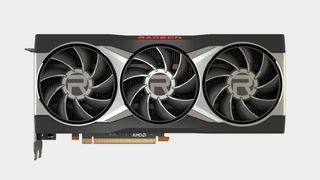
AMD RX 6800 XT verdict
As a red team alternative to Nvidia's high-end graphics cards, there have been few finer than the RX 6800 XT. A highly competitive card that comes so close to a nominal performance differential to the RTX 3080, it is truly an enthusiast card worth consideration for any PC gamer with 4K in their sights.
When choosing between it and Nvidia's second-tier Ampere card, however, it all comes down to a question of immediacy.
The RX 6800 XT is $50 cheaper, delivers high 4K performance, and a hefty VRAM increase over the available memory of the RTX 3080. However, it's easy to argue that the extra $50 spent on the RTX 3080 is money well spent—a small price to pay for greater 4K performance, much improved ray tracing, and DLSS—all available today and with two year's worth of developer support in the bank.
To return to the age-old fine wine analogy for AMD's GPUs—that which supposes its GPUs only get better with age—there's certainly hope for a finer vintage down the line with RDNA 2.
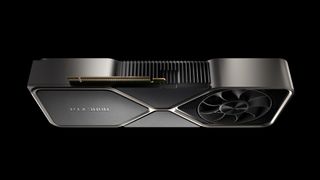
Still can't decide between red or green? Check out our RTX 3080 review to get the complete picture as it stands today.
FidelityFX Super Resolution, for one, is a potential uplift on the way for RDNA 2. We don't yet know anything of game support, availability, or how effective it may be—all things we do already know of Nvidia's DLSS—but AMD is promising a wide reaching and industry-standard approach through its GPUOpen initiative.
With 16GB of memory at its disposal, the RX 6800 XT may well be a better graphics card for the videogames of the future, too, those currently but a sticky note stuck on a whiteboard in some developer's office. We're not quite at a point where it's a boon in anything but those few exceptions to the rule and non-gaming applications, however.
But looking at AMD's architectures as always one step away from 'lolz nvidia get rekt' performance has put a lot of pressure on these cards to magically deliver significantly improved frame rates in a relatively short time frame—the reality of which is that never really happens. At least not to such an extent that your time spent with second-rate performance for a year will be justified twofold and before the next big leap in GPU performance rounds the corner.
A fine wine isn't made overnight, and perhaps that's why that very analogy is more fitting than it was first intended to be. It sets an increasingly difficult bar for AMD to reach within a single generation's lifetime: Development cycles are getting longer and longer, and it's the gradual and heavily telegraphed features introduced and then improved upon with every subsequent generation that have the biggest impact over time.
The fact of it is, not to entirely discount the possibility of improved performance in the future, anything AMD can eke out of these cards eventually is highly variable and nearly impossible to quantify without a crystal ball. But unlike some Radeon launches in the past, that doesn't leave the RX 6800 XT in a tough spot today.
The RX 6800 XT is just as much a viable alternative to Nvidia's high-end as ever, fine wine or no, and more than that it's an impressive show of just what AMD and RTG can deliver when it brings its unified expertise to bear.
Perhaps RDNA and RDNA 2 are better compared to opening moves in a game of chess than some dusty bottle of gone-off grape juice. Leave it to me to replace one vomit-inducingly pretentious analogy with another, but it bear with me. Each turn of the GPU crank incrementally evolves play to eventually move AMD's piece into a dominant position where there's a damn good chance it will actually be able to land check.
The RX 6800 XT leaves AMD in an incredible strong position going forward, and delivers what is required today to get the entire industry to take notice
The development of AMD's Zen CPU architecture has been a familiar tale, albeit one slightly ahead of where we're at with RDNA today. The initial moves in Zen and Zen 2 showed confidence and the clear outline of a game plan taking shape. It wasn't until Zen 3 that we saw AMD's aggressive play first capture of anything significant on Intel's board. Now it's up to Intel to change strategy and think on its feet to avoid more pieces falling.
I won't pretend that the same is definitely going to happen with RDNA 3, and certainly not just because both architectures have a 3 in the name—although you have to admit it would be poetic. But AMD appears to be going from strength to strength with RDNA much as it did with Zen, nowhere more so than with the supposed transparency in new features that AMD is adding in order to make "an architecture that's easy for the industry to adopt."
The RX 6800 XT leaves AMD in an incredible strong position going forward, delivering what is required today to get the entire industry to take notice, and with a strong proposition to offer gamers instantly at launch. And it's no surprise to hear the cooperation between Zen and RDNA engineers had a part to play in all this, too.
All of which is to say that AMD has evolved on what was already a promising architecture in RDNA and delivered it in a fantastic graphics card in the RX 6800 XT. And not the least bit impressive in just how swiftly it has achieved near performance parity with Nvidia. There's still some ways to go to claw back market share from the green team, but step one on RTG's to-do list (build a high-end GPU) can be confidently checked off with the release of the RX 6800 XT.
Now fingers crossed there will be a decent availability this side of New Year's—something tells me it's going to be another all-too-brief scramble for stock.
With the launch of the Radeon RX 6800 XT, AMD can claim 4K-capable performance in earnest. It marks a huge step in the right direction for team red, and delivers genuine competition to Nvidia's high-end.

Jacob earned his first byline writing for his own tech blog. From there, he graduated to professionally breaking things as hardware writer at PCGamesN, and would go on to run the team as hardware editor. He joined PC Gamer's top staff as senior hardware editor before becoming managing editor of the hardware team, and you'll now find him reporting on the latest developments in the technology and gaming industries and testing the newest PC components.
